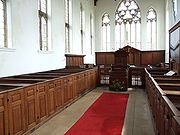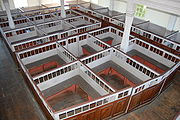
Box pew
Encyclopedia

Pew
A pew is a long bench seat or enclosed box used for seating members of a congregation or choir in a church, or sometimes in a courtroom.-Overview:Churches were not commonly furnished with permanent pews before the Protestant Reformation...
that is encased in panelling and was prevalent in England and other Protestant countries from the 16th to early 19th century.
History in England

Protestant Reformation
The Protestant Reformation was a 16th-century split within Western Christianity initiated by Martin Luther, John Calvin and other early Protestants. The efforts of the self-described "reformers", who objected to the doctrines, rituals and ecclesiastical structure of the Roman Catholic Church, led...
, seating was not customary in churches and only accorded to the lord of the manor, civic dignitaries and finally churchwardens. After 1569 stools and seating were installed in Protestant Churches primarily because the congregation were expected to listen to sermons, and various types of seating were introduced including the box pew. There are records of box pews being installed in Ludlow
Ludlow
Ludlow is a market town in Shropshire, England close to the Welsh border and in the Welsh Marches. It lies within a bend of the River Teme, on its eastern bank, forming an area of and centred on a small hill. Atop this hill is the site of Ludlow Castle and the market place...
parish church before 1577. Box pews provided privacy and allowed the family to sit together. In the 17th century they could include windows, curtains, tables and even fireplaces, and were treated as personal property that could be willed to legatees. Sometimes the paneling was so high it was difficult to see out, and the privacy was used as a cover for non-devotional activity. William Hogarth
William Hogarth
William Hogarth was an English painter, printmaker, pictorial satirist, social critic and editorial cartoonist who has been credited with pioneering western sequential art. His work ranged from realistic portraiture to comic strip-like series of pictures called "modern moral subjects"...
satirised the trend in his paintings and sketches. By the eighteenth century it became normal to install formal box pews instead of random personal constructions. This provided a more classic line to the church, although Sir Christopher Wren
Christopher Wren
Sir Christopher Wren FRS is one of the most highly acclaimed English architects in history.He used to be accorded responsibility for rebuilding 51 churches in the City of London after the Great Fire in 1666, including his masterpiece, St. Paul's Cathedral, on Ludgate Hill, completed in 1710...
objected to pews in his churches. With the mid 19th century church reforms, box pews were generally swept away and replaced by bench pews. However a number of examples still remain in various churches throughout the United Kingdom.
New England

New England
New England is a region in the northeastern corner of the United States consisting of the six states of Maine, New Hampshire, Vermont, Massachusetts, Rhode Island, and Connecticut...
, it was common for the colonial meeting house
Colonial meeting house
In colonial New England, there was little distinction between faith and community. Each community built a meeting house, usually but not always through taxation, and these were used for both religious worship and town business. They were the central focus of the community, and were an important...
to have box pews. Families would typically sit together in a box pew, and it is theorized that the concept of the box pew resulted from the fact that the early meeting house
Meeting house
A meeting house describes a building where a public meeting takes place. This includes secular buildings which function like a town or city hall, and buildings used for religious meetings, particularly of some non-conformist Christian denominations....
s were not heated, and the walls of the box pews would minimize drafts, thus keeping the occupants relatively warmer in the winter.
Further reading
- Speare, Eva A.: Colonial Meeting-Houses of New Hampshire Self-published, Reginald M. Colby, Agent, Littleton, NH, 1938, revised 1955.
- Sinnott, Edmund W.: Meetinghouse and Church in Early New England Bonanza Books, New York, 1963.

